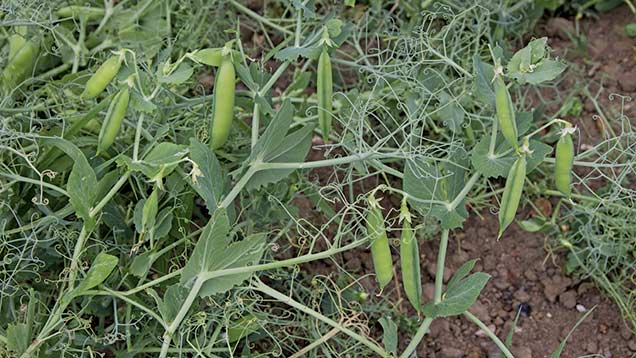Marrowfat peas make a valuable addition to your rotation
 © FLPA/Rex
© FLPA/Rex Strong prices mean marrowfat peas are a valuable option for growers this spring, provided they give the crop the care it needs.
Greater demand from both the UK and Japan for healthy snack products is boosting the prospects for marrowfat peas, says James Wallace of Daltons.
“Marrowfats currently represent just one-third of the total UK pea market,” he reports.
See also: Three pea and bean varieties added to Recommended List
“About 30,000t are produced in England, which is twice the amount grown in Canada and six times the production of New Zealand.”
The UK has a good reputation for marrowfat provenance and quality, he adds. “Our peas are considered to be the best. And stocks have been run down. So the market is very firm and we need more growers.”
Marrowfat peas are very sought after, agrees Andy Bury of Frontier Agriculture, who points out they are currently about £340/t.
“It’s a small, specialist market, where quality is key,” he says. “Having a strong green colour in the pea is also important.”
Peas are not expected to increase in area as much as beans in 2015, due to lack of seed availability, but there is still likely to be 10% growth, he notes.
“With marrowfats, it’s all about doing the job properly. They suit growers who pay attention to detail. ”
While the demand for canning and mushy peas is static, the main market opportunity is for peas going into extruded snack products, he reveals.
“For this market, they are dried and roasted, with flavours being added. The product range is developing all the time.”
News that the Japanese company Calbee is opening a factory on Deeside in north Wales to supply the European market is good news, believes Mr Wallace.
“At the moment, we are sending clean samples to Japan, for them to produce the snacks and then send them back over here.”
Growing tips
A good average yield is 4t/ha, although better producers are getting up to 5t/ha, he reports. “Don’t drill too early. You need to wait for good conditions because peas are not a strong rooting crop, so must get established well.”
Some two-thirds of marrowfat pea seed is now treated with Wakil (cymoxanil + fludioxonil + metalaxyl) for downy mildew control, although Thiraflo (thiram) is also used, he reports. The variety Sakura accounts for two-thirds of the market, with the other popular variety being Kabuki.
The traditional advice to get 70 plants established/sq m may be a bit low, he believes. “There’s some new work being done on seed rates, but we think growers should increase them a bit.”
The other main requirement is for them to be given priority at harvest, says Mr Wallace.
“Colour is important for a quality pea, so any bleaching that occurs in damp, wet conditions is a problem.”
Case study: Whittome Farms, Cambridgeshire
Marrowfat peas have been grown on contract for the last five years at Whittome Farms, near March in Cambridgeshire.
Although they can be more difficult and more variable to grow than winter wheat, the rewards are usually better, says Hugh Whittome.
“There’s more risk,” he acknowledges. “But with the right approach, they do very well. They also help with blackgrass control, provide a fertility benefit for the following crop and leave the soils in good condition. In addition, they meet the new greening requirements.”
Between 60-80ha of marrowfats are grown at Whittome Farms every year, with a target yield of 4.5t/ha. “They are a profitable crop, especially on the lighter soils, which suit them better.”
Mr Whittome grows them as a break from wheat, in a rotation that includes potatoes and sugar beet, allowing him to concentrate on first wheats and get the most of the inherent fertility benefit left by the pea crop.
His contract for 2015, which has been done through Daltons, is for £345/t. “Wheat prices have come back, so they are likely to be one of the best-performing crops for us. They also save about £30/ha on nitrogen in the following wheat crop.”
He grows Sakura, which has always stood well and yielded consistently. “It also has a good, even-quality pea, which is important for the end market.”
In the spring, fine, warm seed-beds are essential, continues Mr Whittome. “They don’t like cold, wet soils. So we drill when the conditions are suitable, rather than by date, and we make sure that the seed-bed is well-consolidated.”
A higher seed rate has been used for the past few years, both to improve the crop’s standing ability and to prevent bird predation. “It also makes the crop more competitive, which helps with weed control.”
A pre-emergence herbicide takes care of most the weed control, but both fungicides and insecticides are required throughout the growing season.
“Aphids and pea moth have to be controlled, as well as disease, so peas can be slightly more expensive to grow than wheat. Including a desiccant, my chemical bill is usually a bit higher.”
However, they have no fertiliser requirement and reduce the nitrogen requirement for the following crop, he points out.
Peas are the first crop to be combined at Whittome Farms, as they are ready before the wheat on fen land, he explains. “We always desiccate, so harvesting is very straightforward. We then store them on the farm at 15% moisture.”

